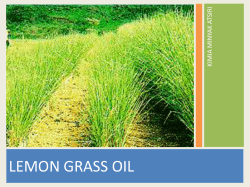
How to use the CMT
How to use the CMT by Rykie Visser, export & district sales manager, DeLaval The California Mastitis Test (CMT) is an easy and inexpensive way to detect mastitis at any stage on the dairy farm. It is best used on fresh milk in the milking parlour. The test can be done at any time. The following equipment is needed to conduct the test: • A four-compartment paddle • A CMT reagent • A scorecard to mark infected quarters of every cow that you test. You can save money When you test all your lactating animals every month and keep good records, you can expect to benefit. By detecting inflammation early, you can reduce udder damage and milk loss. You will also know when to dispose of an animal and what to tell the veterinarian on his next visit. Simple test procedure The procedure for conducting the CMT is simple. Draw foremilk from each quarter into the separate cups of the four-cup plastic paddle. Make sure that there are equal amounts of milk in the cups (about half a teaspoon each). The purple color that results from the CMT, is generally more intense when quarters are infected Add half a teaspoon of test reagent to each cup. Make sure that you use a licensed and approved reagent. Rotate the paddle to mix the reagent and the milk. Now observe for changes in colour and gel formation (after about 10 to 15 seconds after mixing). Milk from a normal quarter remains liquid and flows freely. If there is a moderate infection, the gel that forms will break into small clumps. If there is a strong infection, a gel mass will form and will cling together when the paddle is rotated. Experience and practice are necessary for you to be able to understand and interpret the test. Repeated testing and good records give good management information. Do not use the CMT before the third day after calving or to test milk from cows that are being dried off. For any further information and references, please call Rykie Visser at 082 653 0364, or e-mail rykie.visser@delaval.com. UM UBISI MAIL | DECEMBER 2007 31 How to test for mastitis •Hoe om vir mastitis te toets •Ihlolwa kanjani i-mastitis •Uyivavanyela njani i-mastitis •Kamoo o ka hlahlobang ho bona haeba thele e na le lefu la ho ruruha 1. D raw half a teaspoon of foremilk from each quarter into the separate cups. 1. Trek ‘n halwe teelepel voormelk uit elke kwart in die verskillende koppies in. 1. D onsa uhhafu wethisipuni wobisi lokuqala ekwateni ngayinye uluthele ezinkomishini ezahlukene. 1. T sala isiqingatha setisipuni sobisi lokuqala kwikota nganye uze usifake kwiikomityi ezohlukeneyo. 1. N ka kgatsele e lekanang halofo ya thispuni bakeng sa kotara ka nngwe le ho tshela dikoping tse fapaneng. 2. Add half a teaspoon of test reagent to each cup. 2. Voeg ‘n halwe teelepel toetsreageermiddel in elke koppie. 2. Faka uhhafu wethisipuni lwento yokusiza ukuhlola ukuze ubone ukuthi ubisi lunani enkomishini ngayinye. 2. Faka isiqingatha setisipuni yomchiza wokuvavanya (reagent) kwikomityi nganye. 2. Tshela halofo ya thispuni ya moriana koping ka nngwe ho hlahloba haeba ho na le phetoho e itseng. 3. 3. 3. 3. 3. Gently shake to mix the reagent and the milk. Skud liggies om die reageermiddel en die melk te meng. Khuxuza ukuze uxube into yokusiza ukuhlola kanye nobisi. Hlukuhla ngobunono uxube umchiza nobisi. Hlokohla moriana ona le lebese. 4. 4. 4. 4. 4. Look for changes in colour and gel formation. Kyk vir kleurveranderinge en jelvorming. Bheka izinguquko embaleni nasekwakhekeni kwejeli. Jonga utshintsho kumbala kunye nokwakheka kwejeli. Sheba haeba ho na le diphetoho mmaleng wa lebese le haeba lebese le ho fetoha mafi. •Good milk remains liquid and flows freely. Moderate infection: The gel breaks into small clumps. Strong infection: A gel mass will cling together when the paddle is rotated. 32 UBISI MAIL | DECEMBER 2007 •Goeie melk bly vloeibaar en vloei vrylik. Matige infeksie: Die jel breek op in klein klonte. Ernstige infeksie: ‘n Jelmassa sal saamklou wanneer die houertjie rondgedraai word. •Ubisi oluhle luhlala luwuketshezi futhi luhambe kalula. Ukutheleleka okukahle: Ijeli iyaqhekeka ibe yizigaxa ezincane. Ukutheleleka okunamandla: Iqoqo lejeli liyabumbana uma kugoqozwa. •Ubisi olulungileyo luhlala lululwelo kwaye lugeleze ngokukhululekileyo. Usulelo oluphakathi: Ijeli iye yohlukane ibe zizigaqa ezincinane. Usulelo olungamandla: Imfumba yejeli iya kubambana kunye xa kuzanyiswa ngephini. •Lebese le lokileng lebese e ntse e le mokedi-kedi mme le ella habobebe. Tshwaetso e mahareng: Mafi a bopa dikaqa tse nyenyane. Tshwaetso e matla: Mafi a tla kgomarela hammoho ha o a fuduwa. •Important! Test all your cows every month and keep good records. •Belangrik! Toets jou koeie elke maand en hou goeie rekords by. •Okubalulekile! Izinkomo zakho zihlole nyanga zonke futhi ugcine amarekhodi amahle. •Okubalulekileyo! Vavanya zonke iinkomo zakho nyanga nganye uze ugcine iirekhodi ezilungileyo. •Ho bohlokwa! Lekola dikgomo tsohle tsa hao kgwedi e nngwe le e nngwe le ho boloka ditlaleho tse ntle. UM UBISI MAIL | DECEMBER 2007 33
© Copyright 2025





















